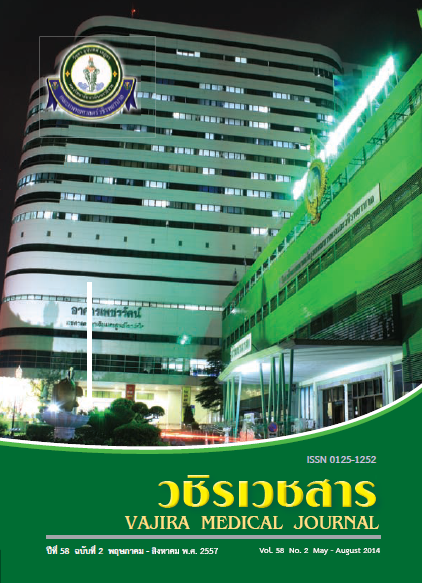Decontamination Process and Factors Related to Contamination of Laryngoscope Blades and Handles
Main Article Content
Abstract
Objective: To investigate bacterial and proteinaceous material contamination of ‘ready to use’ laryngoscope blades/handles and the factors related to its contamination at HRH Princess Maha Chakri Sirindhorn Medical Center, Nakhon Nayok.
Methods: Hospital survey on decontamination of laryngoscope blades and handles were observed and 70 participants of healthcare workers (HCWs) were asked to fill up self-answered questionnaires regarding experience on decontamination during their routine work. The effectiveness of laryngoscope decontamination was determined by total bacterial count and proteinaceous materials deposit with 6% erythrosin B solution from 326 swab samples of ‘ready to use’ laryngoscope blades (214), handles (106) and boxes (6) from September 2010 to May 2011.
Results: Various processes of laryngoscopes decontamination were practiced among 70 HCWs. Appropriate decontamination of blades and handles were observed in 50% and 2.9% of the participants, respectively. Bacterial contamination were found in 50.5% of laryngoscope blades, 46.2% of handles and 83.3% of boxes. Bacterial contamination levels of individual sample ranged from 3×104 to 3.6×104 CFU/sample. Approximately 56% of 162 positive samples were contaminated with bacteria less than 102 CFU/sample. Predominate bacteria was coagulase-negative staphylococci (82.7%). Other nosocomial pathogens were also isolated such as Acinetobacter baumannii (4.9%), Pseudomonas aeruginosa (3.7%), and methicillin-resistant Staphylococcus aureus (2.48%). Proteinaceous contamination rates were 60.9% on blades and 72.9% on handles. Bacterial contamination rates on blades and handles were significantly different (p=0.001 and 0.02, respectively) among departments and time intervals from the last decontamination. Inappropriate blade cleaning was significantly associated with bacterial contamination 5.92 times of those with appropriate cleaning (p=0.0001).
Conclusion: Based on high bacterial contamination of the present study, we recommend the pre-use and on-site disinfection of the ‘ready to use’ laryngoscope blade and handle with 70% alcohol before each use. The guidelines and training on laryngoscope decontamination was necessary for a hospital-wide practice.


